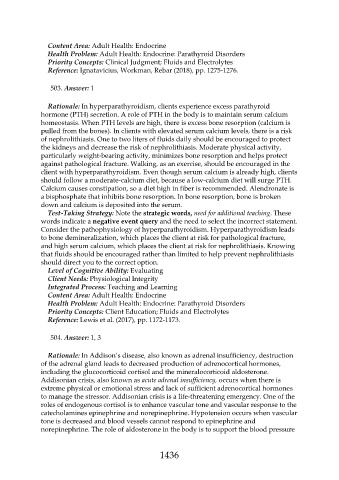Page 1436 - Saunders Comprehensive Review For NCLEX-RN
P. 1436
Content Area: Adult Health: Endocrine
Health Problem: Adult Health: Endocrine: Parathyroid Disorders
Priority Concepts: Clinical Judgment; Fluids and Electrolytes
Reference: Ignatavicius, Workman, Rebar (2018), pp. 1275-1276.
503. Answer: 1
Rationale: In hyperparathyroidism, clients experience excess parathyroid
hormone (PTH) secretion. A role of PTH in the body is to maintain serum calcium
homeostasis. When PTH levels are high, there is excess bone resorption (calcium is
pulled from the bones). In clients with elevated serum calcium levels, there is a risk
of nephrolithiasis. One to two liters of fluids daily should be encouraged to protect
the kidneys and decrease the risk of nephrolithiasis. Moderate physical activity,
particularly weight-bearing activity, minimizes bone resorption and helps protect
against pathological fracture. Walking, as an exercise, should be encouraged in the
client with hyperparathyroidism. Even though serum calcium is already high, clients
should follow a moderate-calcium diet, because a low-calcium diet will surge PTH.
Calcium causes constipation, so a diet high in fiber is recommended. Alendronate is
a bisphosphate that inhibits bone resorption. In bone resorption, bone is broken
down and calcium is deposited into the serum.
Test-Taking Strategy: Note the strategic words, need for additional teaching. These
words indicate a negative event query and the need to select the incorrect statement.
Consider the pathophysiology of hyperparathyroidism. Hyperparathyroidism leads
to bone demineralization, which places the client at risk for pathological fracture,
and high serum calcium, which places the client at risk for nephrolithiasis. Knowing
that fluids should be encouraged rather than limited to help prevent nephrolithiasis
should direct you to the correct option.
Level of Cognitive Ability: Evaluating
Client Needs: Physiological Integrity
Integrated Process: Teaching and Learning
Content Area: Adult Health: Endocrine
Health Problem: Adult Health: Endocrine: Parathyroid Disorders
Priority Concepts: Client Education; Fluids and Electrolytes
Reference: Lewis et al. (2017), pp. 1172-1173.
504. Answer: 1, 3
Rationale: In Addison’s disease, also known as adrenal insufficiency, destruction
of the adrenal gland leads to decreased production of adrenocortical hormones,
including the glucocorticoid cortisol and the mineralocorticoid aldosterone.
Addisonian crisis, also known as acute adrenal insufficiency, occurs when there is
extreme physical or emotional stress and lack of sufficient adrenocortical hormones
to manage the stressor. Addisonian crisis is a life-threatening emergency. One of the
roles of endogenous cortisol is to enhance vascular tone and vascular response to the
catecholamines epinephrine and norepinephrine. Hypotension occurs when vascular
tone is decreased and blood vessels cannot respond to epinephrine and
norepinephrine. The role of aldosterone in the body is to support the blood pressure
1436

